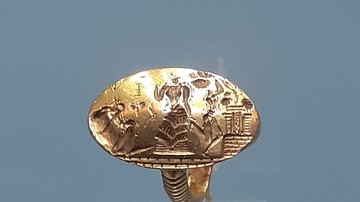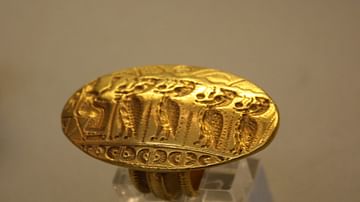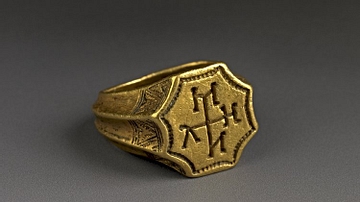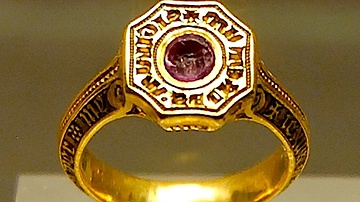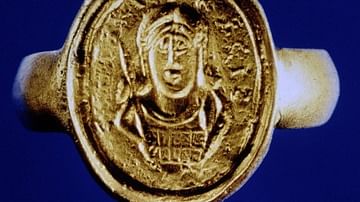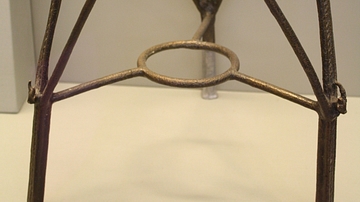Illustration
Engraved gold signet ring from Tiryns, c. 15th century BCE.
National Archaeological Museum, Athens.
The largest ring (7.5 × 3.5 cm) handed down to us from the Mycenaean civilization, the Tiryns signet ring flags up the strong vein of Minoan influence on the Mycenean cultural flourish between c. 1400 and c. 1200 BCE. The ring was excavated in 1915 from the lower town of Tiryns, an archaeological site in Argolis, Peloponnese. The site is mythically associated with Heracles (Hercules) and his Twelve Labours, an idea empowered by the architectural overlaps between the vast megaron (reception hall) of the Tiryns palace and the adjacent temple of Hera.
The goddess on the ring, sitting on a throne and raising a libation cup, is identified with Demeter based on the interpretation of single-dot patterns on her long dress as grain seeds. She keeps a wide, shallow bowl under her feet, and receives the procession of lion-headed, daemonic libation-bearers. These are separated by ears of wheat, and their eagle-like bodies might be mirroring the eagle that sits behind the throne as the symbol of authority and rulership. Ears of wheat and grains can also be seen as embellishments for the sun and the moon at the top part of the carving, which may represent a nychthemeros (night-and-day) sky symbolising the cycle of seasons.
References
- Archaeological Sites of Mycenae and Tiryns, accessed 3 Feb 2022.
- Collection of Mycenaean Antiquities, accessed 3 Feb 2022.
- Museums of Greece, accessed 3 Feb 2022.
- ON THE FAMOUS MYCENAEAN SIGNET RING, CMS I, 179, OF THE TIRYNS TREASURE, accessed 3 Feb 2022.
Cite This Work
APA Style
Zde. (2022, February 17). Tiryns Gold Signet Ring. World History Encyclopedia. Retrieved from https://www.worldhistory.org/image/15223/tiryns-gold-signet-ring/
Chicago Style
Zde. "Tiryns Gold Signet Ring." World History Encyclopedia. Last modified February 17, 2022. https://www.worldhistory.org/image/15223/tiryns-gold-signet-ring/.
MLA Style
Zde. "Tiryns Gold Signet Ring." World History Encyclopedia. World History Encyclopedia, 17 Feb 2022, https://www.worldhistory.org/image/15223/tiryns-gold-signet-ring/. Web. 16 Apr 2025.


